Birdfinding.info ⇒ Generally uncommon across most of its large, mostly remote range, but often conspicuous when present. In the continental U.S., Sax-Zim Bog in Minnesota is probably the most consistent, readily accessible site. In Alaska, it can often be found along the highway between Fairbanks and Tok Junction. In Canada, Route 11 northeast of Winnipeg is fairly consistent. In Europe, it is found regularly across most of central and northern Scandinavia—most readily in remote areas such as northern Finland (e.g., around Oulu), and Finnmark (e.g., Tana).
Northern Hawk-Owl
Surnia ulula
Taiga belt of Eurasia and North America, where it occurs primarily in mixed semiopen and lightly wooded landscapes, such as bogs, muskegs, burns, and patchworks of forest and meadow.

Approximate distribution of the Northern Hawk-Owl. © Xeno-Canto 2022
In Eurasia, it is resident across the taiga from Fennoscandia east to Chukotka, the Kamchatka Peninsula, and Sakhalin. In central Asia, its range extends south into the Tian Shan region of Kyrgyzstan.
In North America, resident throughout most of Alaska and Canada north to treeline and east to Newfoundland. The southern limit of its breeding range is mostly some distance north of the continental U.S., but extends south of it into Minnesota.
Somewhat nomadic, wandering in response to prey population collapses and bonanzas. In winter, vagrants sometimes wander south of the breeding range to central Europe, northeastern China, and the northern third of the continental U.S. It has been recorded accidentally south to Belgium, Switzerland, Slovakia, Oregon, southern Idaho, Wyoming, Nebraska, Iowa, West Virginia, New Jersey, and Bermuda.
Identification
Distinctive: a medium-sized owl that resembles a falcon or Accipiter in its shape and behavior. Unlike most owls, it is primarily diurnal and habitually perches in the open—often on the uppermost point of a prominent conifer or dead snag.
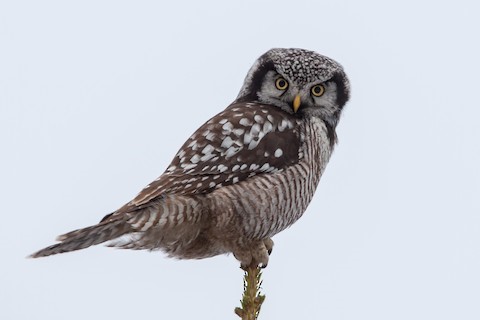
Northern Hawk-Owl, S. u. caparoch, on a typically prominent treetop perch. (Eau Claire, Wisconsin.) © Jeremy Meyer
Its head appears relatively small and its tail is proportionately long and thin. The face is distinctively patterned: a white facial disk framed by bold black bars that branch forward over the eyes. The crown is black with extremely dense white spots. The side of the head has a white ear-patch that is bordered by another black bar. The eyes are bright-yellow and the bill is yellowish.
The upperparts are mostly dark brown or blackish with variable white spotting that is concentrated along the scapulars. When seen in flight, these white spots often form a distinct whitish bar.
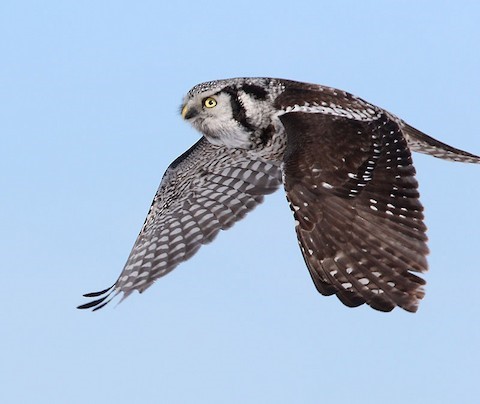
Northern Hawk-Owl, S. u. caparoch, dorsal view in flight, showing sparse white spotting on wings and white scapular bar. (Ottawa, Ontario.) © Wilson Hum
The underparts are densely barred throughout—white with blackish or brown bars. When seen in flight from below, the entire underside—body, wings, and tail—appears thoroughly barred.
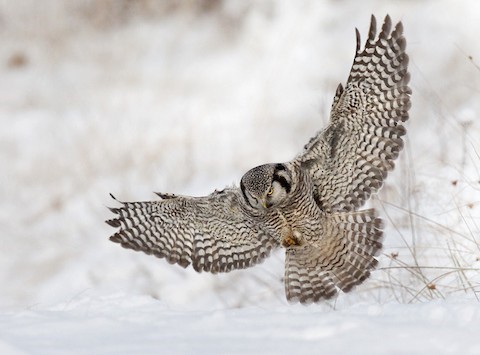
Northern Hawk-Owl, S. u. ulula, ventral view in flight, showing extensively barred underparts. (Jönköpings Län, Sweden.) © Lars Petersson
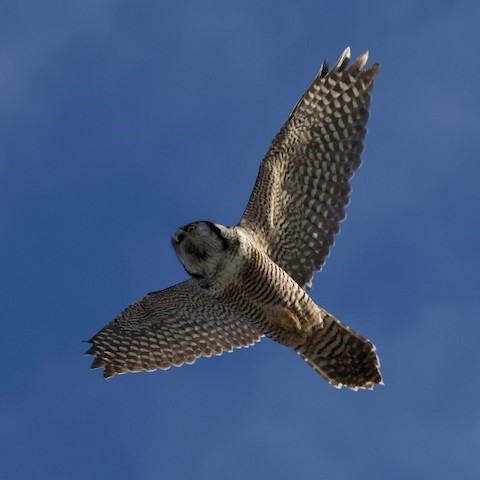
Northern Hawk-Owl, S. u. caparoch. (York, Ontario.) © Liam Ragan
Eurasian and American populations differ in their overall coloration. Eurasian birds typically show stronger contrast: blacker upperparts, blacker bars, but also more extensively white, especially on the underparts.
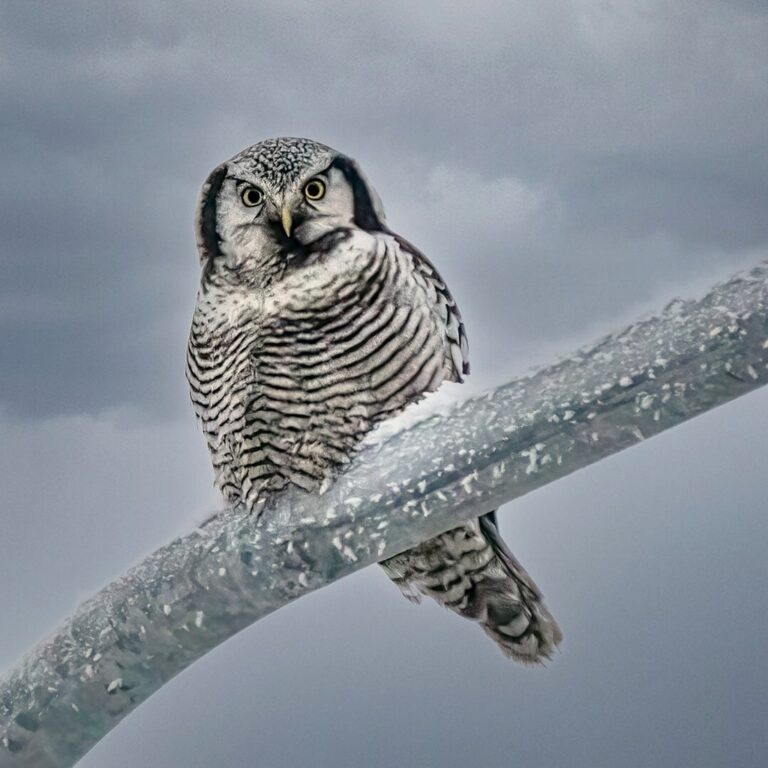
Northern Hawk-Owl, S. u. ulula, showing blackish barring on extensively white underparts. (Kållbyvägen, Kolppi, Österbotten, Finland; December 4, 2022.) © lenacs
American birds tend to have browner upperparts, browner bars, with less white on the underparts and sparser white spots on the upperparts.
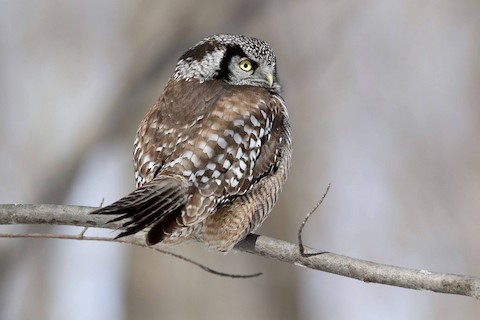
Northern Hawk-Owl, S. u. caparoch, showing brown upperparts typical of this subspecies. (Gatineau, Quebec.) © Serge Rivard
Notes
Polytypic species consisting of three recognized subspecies.
More Images of the Northern Hawk-Owl
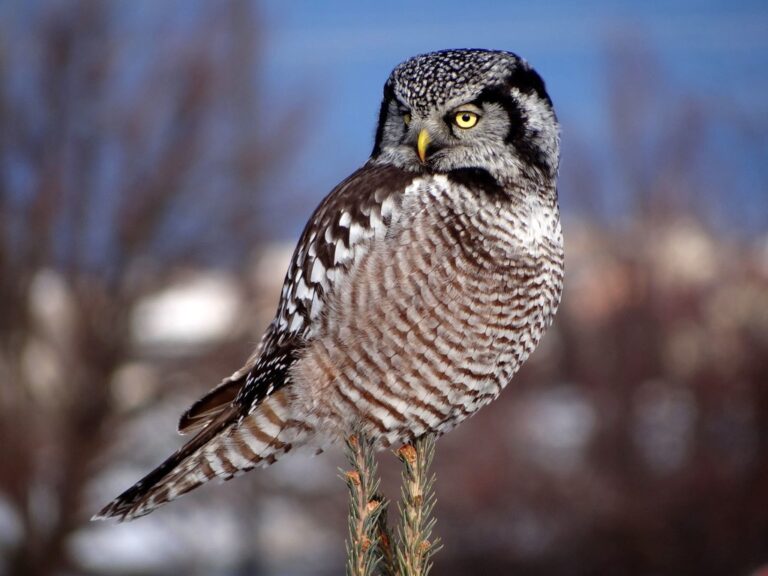
Northern Hawk-Owl, S. u. caparoch. (Moscow, Idaho; December 2013.) © Terry Gray

Northern Hawk-Owl, S. u. caparoch. (Marquette County, Minnesota; November 2019.) © Steve Waller
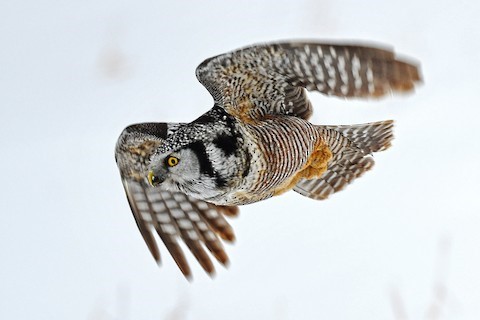
Northern Hawk-Owl, S. u. caparoch. (Athabasca, Alberta.) © Chris Rees

Northern Hawk-Owl, S. u. caparoch. (Athabasca, Alberta.) © Chris Rees
References
Alderfer, J., and J.L. Dunn. 2021. National Geographic Complete Birds of North America (Third Edition). National Geographic Society, Washington, D.C.
BirdLife International. 2021. Surnia ulula. The IUCN Red List of Threatened Species 2021: e.T22689189A206518616. https://dx.doi.org/10.2305/IUCN.UK.2021-3.RLTS.T22689189A206518616.en. (Accessed December 31, 2022.)
Brazil, M. 2009. Birds of East Asia. Princeton University Press.
eBird. 2022. eBird: An online database of bird distribution and abundance. Cornell Lab of Ornithology, Ithaca, N.Y. http://www.ebird.org. (Accessed December 31, 2022.)
König, C., and F. Weick. 2008. Owls of the World (Second Edition). Yale University Press.
Mikkola, H. 2012. Owls of the World: A Photographic Guide. Firefly Books, London.
Mullarney, K., L. Svensson, D. Zetterström, and P.J. Grant. 1999. Birds of Europe. Princeton University Press.
Salt, W.R., and J.R. Salt. 1976. The Birds of Alberta. Hurtig Publishers, Edmonton, Alberta.
Xeno-Canto. 2022. Northern Hawk-Owl – Surnia ulula. https://xeno-canto.org/species/Surnia-ulula. (Accessed December 31, 2022.)
